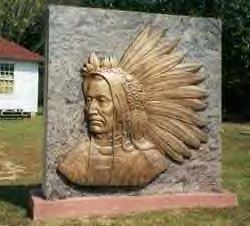|
|
Canku Ota |
|
|
(Many Paths) |
||
|
An Online Newsletter Celebrating Native America |
||
|
July 28, 2001 - Issue 41 |
||
|
|
||
|
Pamunkey Tribe Invited to Tell its Story |
||
|
by Lawrence Latane III-Richmond Times Dispatch-July 19, 2001 |
 KING WILLIAM
- Virginia's Pamunkey Indian Tribe will introduce itself to the world in 2004 when the National Museum of the American
Indian opens in Washington on the National Mall. KING WILLIAM
- Virginia's Pamunkey Indian Tribe will introduce itself to the world in 2004 when the National Museum of the American
Indian opens in Washington on the National Mall.The tribe is among nine from the United States, Canada and South America invited to tell their stories in special exhibits highlighting contemporary Indian culture. "We've been hiding too long," Vice Chief Warren Cook said from his home on the 1,150-acre Pamunkey Indian Reservation, where the Pamunkey River creates a miles-wide vista as it loops through freshwater marshes and green woods. The view could have changed but little from 1677, when a treaty with the king of England established the reservation about 30 miles northeast of Richmond on a peninsula that had been home to American Indians for millenniums. Cook finds stone blades and projectile points outside his doorstep dating back 8,000 years. "They want us to show who we are and a little about our history, but the big part is who we are today," Cook said. "We're calling today the past 150 years." Cook, who is leading the tribal effort to plan its exhibit, has most of the timeline clinched: His father, former Chief Tecumseh "Deerfoot" Cook, is still active at 101. The elder Cook, in turn, learned tribal stories from his father, George Major Cook, who died in 1930 after amassing a large collection of artifacts that later formed the basis for the Pamunkey Indian Museum on the reservation. The younger Cook said the tribe welcomes the chance to put itself on display in Washington when the Smithsonian Institution opens the new national museum under the administration of founding director W. Richard West, a Southern Cheyenne Indian. "So many people still think you live in long houses," such as the sapling-and-hide structures described by early colonists, and carry misconceptions about the Indian way of life, Cook said. Museum spokeswoman Carol Grace Hicks said the Pamunkey will tell their story in an opening exhibition, titled "Our Lives," that will feature eight other tribes, including the Yakama Nation of Washington state, the Inuit of Igloolik, from Numavut, Canada, and a yet to be announced South American tribe. The spectrum of tribes, from the Arctic to the tropics, "show the whole diversity of native culture," Hicks said. "These nine groups have the opportunity to present themselves" so museum visitors can learn about the tribes from the tribes' perspective. "You will really come away with an understanding of the contemporary identities of the tribes today." Cook's tribe, the Pamunkey, has a proud past steeped in Virginia lore and spiced with tales of Powhatan, the powerful chief who ruled a confederacy of coastal Virginia tribes when England was struggling to get a foothold in Virginia at Jamestown in 1607. Since that pivotal "contact period," which eventually crushed Powhatan's empire and eradicated and isolated Indian villages, the Pamunkey have kept a low profile in rural King William County. Many of the 75-member tribe's men still follow the seasons as fishermen, trappers and waterfowl hunting guides in the Pamunkey River wetlands. Many of the women maintain a tradition of pottery-making, which saw a revival in the Great Depression when the state built a pottery school on the reservation. But, just as many tribe members, Cook said, get in their cars and commute to Richmond, where some of the Pamunkey tribe members own businesses or hold jobs. "We've changed," Cook said, "along with everyone else." |
|
|
|
Pamunkey Tribe of Virginia |
|
|
||
|
|
||
| Canku Ota is a free Newsletter celebrating Native America, its traditions and accomplishments . We do not provide subscriber or visitor names to anyone. Some articles presented in Canku Ota may contain copyright material. We have received appropriate permissions for republishing any articles. Material appearing here is distributed without profit or monetary gain to those who have expressed an interest. This is in accordance with Title 17 U.S.C. section 107. | ||
|
Canku Ota is a copyright © 2000, 2001 of Vicki Lockard and Paul Barry. |
||
|
|
|
|
|
The "Canku Ota - A Newsletter Celebrating Native America" web site and its design is the |
||
|
Copyright © 1999, 2000, 2001 of Paul C. Barry. |
||
|
All Rights Reserved. |
||

